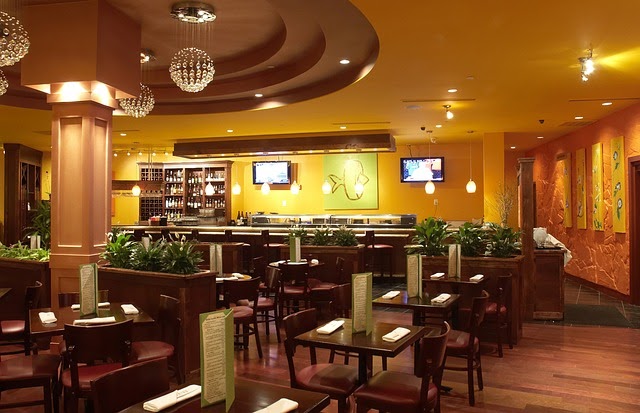Asian Fusion Restaurant: A Distinct Dining Experience in the Heart of Islamabad
Wiki Article
Savor Authentic Oriental Cuisine With a Pan-Asian Spin for a Culinary Journey
Getting started on a cooking journey with genuine Asian cuisine, enhanced with a Pan-Asian twist, provides an unique possibility to discover the abundant tapestry of tastes that specify the area's varied culinary customs. As you consider these enticing meals, take into consideration the social narratives and historic influences that form them, each bite offering a tale waiting to be uncovered. Fine dining experience Islamabad.
Discovering Pan-Asian Tastes
In the world of global gastronomy, Pan-Asian cuisine stands apart for its impressive diversity and the harmonious interplay of tastes from various Oriental societies. This culinary approach commemorates the distinct active ingredients and rich traditions found throughout the continent, producing a tapestry of tastes that is both interesting and gratifying. Secret to Pan-Asian food is its capacity to stabilize different flavors-- sweet, salty, spicy, and sour-- while highlighting the freshness and high quality of each active ingredient.From the umami-rich soy sauce of Japan to the intense chili peppers of Thailand, Pan-Asian food supplies a comprehensive scheme of flavors. These elements are usually combined in inventive means, boosting recipes with layers of intricacy. For example, using fragrant herbs such as lemongrass and cilantro, common in Vietnamese and Thai cuisine, includes a revitalizing illumination to recipes, while the unification of coconut milk delivers a velvety, rich structure.
The emphasis on fresh fruit and vegetables and fragrant spices ensures that each dish is not just a feast for the taste buds however likewise for the senses. Pan-Asian cuisine invites restaurants to start a culinary trip, discovering the huge and varied landscapes of Oriental gastronomy with every bite.
Blend Recipes to Try
While Pan-Asian cuisine is commemorated for its conventional tastes, the modern cooking landscape is significantly accepting blend recipes that blend these timeless elements with influences from other regions. This cutting-edge technique not just honors the abundant heritage of Asian culinary arts however additionally introduces novel taste experiences that appeal to contemporary tastes.
A prime instance of such a blend recipe is the Korean-Mexican taco, where seasoned bulgogi beef is covered in a cozy tortilla, topped with kimchi and a zesty gochujang-infused salsa. This mix weds the bold, full-flavored flavors of Korea with the lively, fresh aspects of Mexican food. Similarly, sushi burritos have actually gained popularity, integrating the fragile virtuosity of Japanese sushi with the hearty, hand-held ease of a burrito, commonly including blend ingredients like tempura shrimp and avocado with a drizzle of wasabi mayo.
One more significant recipe is Thai curry ramen, which instills the luscious, fragrant seasonings of Thai curry right into the calming brew of typical Japanese ramen, producing an unified mix that entices the detects. These combination dishes prolong beyond mere novelty; they represent a culinary discussion between cultures, encouraging exploration and advancement in the globe of Pan-Asian food.
Essential Active Ingredients and Flavors
To really value Pan-Asian cuisine, one must comprehend the vital components and spices that form its foundation. This diverse cooking design draws from an abundant tapestry of Oriental customs, utilizing a harmonious mix of structures and flavors. Trick components include soy sauce, fish sauce, and oyster sauce, which impart a full-flavored umami deepness important to Oriental dishes. Corresponding to these are rice vinegar and mirin, offering a delicate level of acidity and sweetness.Fragrant aspects are critical, with garlic, ginger, and lemongrass being common throughout numerous Pan-Asian recipes. These active ingredients offer a great smelling base that enhances the complexity of tastes. Seasonings such as star anise, cardamom, and cinnamon present heat and personality, echoing influences from areas like China and India.

Cooking Methods and Tips
Understanding the art of Pan-Asian cuisine requires familiarity with its distinctive food preparation techniques, each adding to the vivid tapestry of flavors this cooking practice is commemorated for. Central to these techniques is the stir-fry, a fast cooking method that protects the nutritional integrity and vibrant colors of active ingredients. Utilizing a frying pan, the stir-fry approach permits even warmth distribution, important for achieving the characteristic appearance and taste balance of Pan-Asian meals.Another fundamental strategy is steaming, particularly widespread in Chinese food. This gentle asian fusion restaurant approach maintains the all-natural flavors and nutrients of components, making it ideal for fish and shellfish and vegetables. Dumplings, a beloved staple, often gain from steaming, causing soft, succulent textures.
Grilling, additionally essential, imparts great smoky midsts to meals such as Korean bulgogi or Japanese yakitori (Chinese food Islamabad). This technique often entails seasoning components, permitting flavors to pass through deeply before cooking over an open flame or warmer
Finally, understanding the art of stabilizing flavors-- wonderful, sour, salted, bitter, and umami-- is vital. Appropriately layering these aspects can elevate a recipe from ordinary to extraordinary, providing a complex and pleasing cooking experience that embodies the essence of Pan-Asian food.
Dining Experiences Worldwide
Throughout the globe, Pan-Asian food uses an unequaled eating experience, celebrated for its abundant tapestry of tastes and lively presentations. This cooking phenomenon has actually transcended cultural borders, recording the hearts and tastes buds of food fanatics worldwide. In multicultural cities like New York, London, and Sydney, Pan-Asian restaurants function as fusions where cooking customs from Thailand, Japan, China, and beyond merge, giving restaurants with a diverse mix of meals that highlight the region's variety.The global charm of Pan-Asian cuisine lies in its capacity to use both credibility and technology. Chefs masterfully wed conventional components such as lemongrass, soy sauce, and miso with modern methods, leading to dishes that are both acquainted and refreshingly brand-new. This fusion permits restaurants to embark on a cooking trip that respects heritage while embracing modernity.
Additionally, eating experiences are elevated via thoughtfully created environments that reflect the values of Pan-Asian visual appeals. From minimal Japanese-inspired insides to vivid Thai-themed rooms, each restaurant offers a distinct atmosphere that complements the culinary offerings. Because of this, clients are not simply eating a meal yet partaking in a social experience, making Pan-Asian dining a truly international phenomenon.
Verdict
The expedition of Pan-Asian cuisine provides an extensive understanding of the intricate interplay of flavors and culinary traditions throughout Asia. By embracing combination meals such as Thai curry ramen and sushi burritos, the culinary trip not only highlights the flexibility of typical active ingredients but additionally showcases cutting-edge modern techniques. This gastronomic adventure, enriched by cooking techniques and necessary spices, offers an unique chance to value the cultural diversity and cooking creativity that define Pan-Asian cuisine on a worldwide range.Getting started on a culinary trip through authentic Oriental food, enhanced with a Pan-Asian spin, offers an one-of-a-kind opportunity to explore the abundant tapestry of flavors that define the region's varied cooking practices.In the world of global gastronomy, Pan-Asian cuisine stands out for its exceptional variety and the unified interplay of tastes from different Eastern cultures. Secret to Pan-Asian cuisine is its capability to stabilize different tastes-- wonderful, salted, spicy, and sour-- while highlighting the quality and top quality of each active ingredient.

Report this wiki page